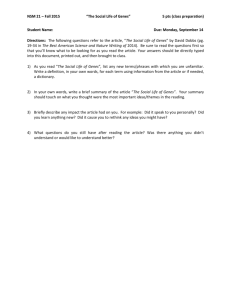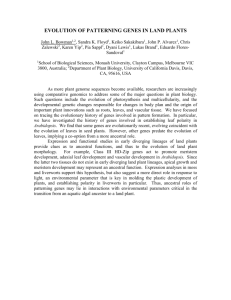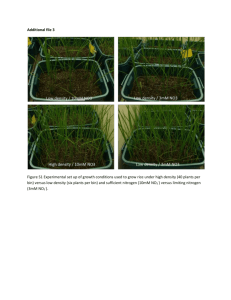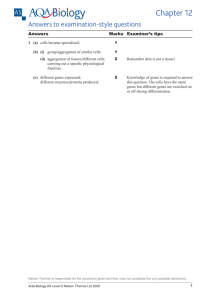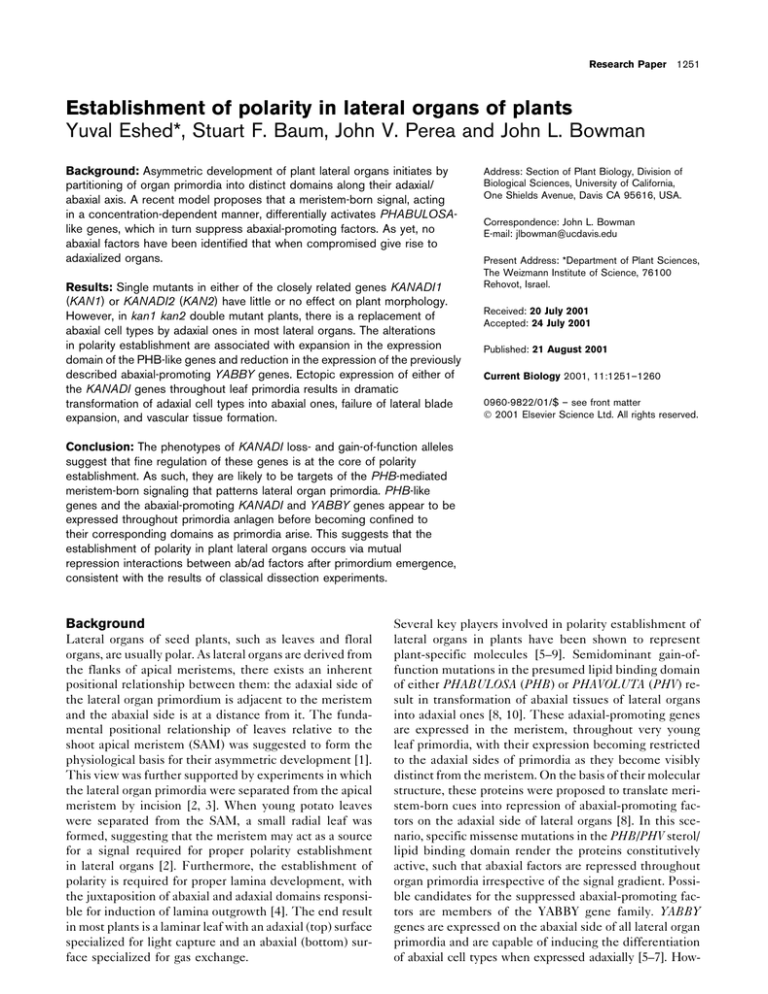
Research Paper 1251
Establishment of polarity in lateral organs of plants
Yuval Eshed*, Stuart F. Baum, John V. Perea and John L. Bowman
Background: Asymmetric development of plant lateral organs initiates by
partitioning of organ primordia into distinct domains along their adaxial/
abaxial axis. A recent model proposes that a meristem-born signal, acting
in a concentration-dependent manner, differentially activates PHABULOSAlike genes, which in turn suppress abaxial-promoting factors. As yet, no
abaxial factors have been identified that when compromised give rise to
adaxialized organs.
Results: Single mutants in either of the closely related genes KANADI1
(KAN1) or KANADI2 (KAN2) have little or no effect on plant morphology.
However, in kan1 kan2 double mutant plants, there is a replacement of
abaxial cell types by adaxial ones in most lateral organs. The alterations
in polarity establishment are associated with expansion in the expression
domain of the PHB-like genes and reduction in the expression of the previously
described abaxial-promoting YABBY genes. Ectopic expression of either of
the KANADI genes throughout leaf primordia results in dramatic
transformation of adaxial cell types into abaxial ones, failure of lateral blade
expansion, and vascular tissue formation.
Address: Section of Plant Biology, Division of
Biological Sciences, University of California,
One Shields Avenue, Davis CA 95616, USA.
Correspondence: John L. Bowman
E-mail: jlbowman@ucdavis.edu
Present Address: *Department of Plant Sciences,
The Weizmann Institute of Science, 76100
Rehovot, Israel.
Received: 20 July 2001
Accepted: 24 July 2001
Published: 21 August 2001
Current Biology 2001, 11:1251–1260
0960-9822/01/$ – see front matter
2001 Elsevier Science Ltd. All rights reserved.
Conclusion: The phenotypes of KANADI loss- and gain-of-function alleles
suggest that fine regulation of these genes is at the core of polarity
establishment. As such, they are likely to be targets of the PHB-mediated
meristem-born signaling that patterns lateral organ primordia. PHB-like
genes and the abaxial-promoting KANADI and YABBY genes appear to be
expressed throughout primordia anlagen before becoming confined to
their corresponding domains as primordia arise. This suggests that the
establishment of polarity in plant lateral organs occurs via mutual
repression interactions between ab/ad factors after primordium emergence,
consistent with the results of classical dissection experiments.
Background
Lateral organs of seed plants, such as leaves and floral
organs, are usually polar. As lateral organs are derived from
the flanks of apical meristems, there exists an inherent
positional relationship between them: the adaxial side of
the lateral organ primordium is adjacent to the meristem
and the abaxial side is at a distance from it. The fundamental positional relationship of leaves relative to the
shoot apical meristem (SAM) was suggested to form the
physiological basis for their asymmetric development [1].
This view was further supported by experiments in which
the lateral organ primordia were separated from the apical
meristem by incision [2, 3]. When young potato leaves
were separated from the SAM, a small radial leaf was
formed, suggesting that the meristem may act as a source
for a signal required for proper polarity establishment
in lateral organs [2]. Furthermore, the establishment of
polarity is required for proper lamina development, with
the juxtaposition of abaxial and adaxial domains responsible for induction of lamina outgrowth [4]. The end result
in most plants is a laminar leaf with an adaxial (top) surface
specialized for light capture and an abaxial (bottom) surface specialized for gas exchange.
Several key players involved in polarity establishment of
lateral organs in plants have been shown to represent
plant-specific molecules [5–9]. Semidominant gain-offunction mutations in the presumed lipid binding domain
of either PHABULOSA (PHB) or PHAVOLUTA (PHV) result in transformation of abaxial tissues of lateral organs
into adaxial ones [8, 10]. These adaxial-promoting genes
are expressed in the meristem, throughout very young
leaf primordia, with their expression becoming restricted
to the adaxial sides of primordia as they become visibly
distinct from the meristem. On the basis of their molecular
structure, these proteins were proposed to translate meristem-born cues into repression of abaxial-promoting factors on the adaxial side of lateral organs [8]. In this scenario, specific missense mutations in the PHB/PHV sterol/
lipid binding domain render the proteins constitutively
active, such that abaxial factors are repressed throughout
organ primordia irrespective of the signal gradient. Possible candidates for the suppressed abaxial-promoting factors are members of the YABBY gene family. YABBY
genes are expressed on the abaxial side of all lateral organ
primordia and are capable of inducing the differentiation
of abaxial cell types when expressed adaxially [5–7]. How-
1252 Current Biology Vol 11 No 16
ever, simultaneous loss-of-function of two redundant
YABBY genes, FILAMENTOUS FLOWER (FIL) and
YABBY3 (YAB3), does not result in a conspicuous gain of
adaxial cell fates [5].
On the basis of the unique genetic interaction in Arabidopsis carpels between CRABS CLAW (CRC), the founding member of the YABBY gene family, and KANADI1
(KAN1), we suggested the presence of a second abaxialpromoting pathway that overlaps with the function of the
YABBY genes [7]. While numerous morphological differences differentiate the two sides of all lateral organs, carpels (the female floral organs that give rise to the fruit)
provide a simple and sensitive organ to assay polarity.
Placentae, bearing ovules, develop only internally (adaxially), and, therefore, loss of abaxial tissues and gain of
adaxial ones results in formation of ectopic external
ovules. Plants mutated for both crc and either kan1 or
pickle (pkl AKA gymnos) develop duplications of placentae
in the medial regions of the abaxial sides (external) of
their carpels. Since neither individual mutant displays
these aberrations, such synergism suggests redundancy,
either in a single pathway or in independent pathways.
These observations led to the formulation of a model
suggesting that distinct mechanisms promote polarity establishment of Arabidopsis carpels [7]. According to this
model, CRC promotes abaxial cell fate in the carpels, but
its role is masked either by other abaxial-promoting genes
such as KAN1 or by genes, such as PKL, that temporally
restrict meristematic activities.
To elaborate and test this model, a screen for genetic
enhancers of pkl and kan1 was carried out in the kan1-2
pkl-12 background. The primary goal of the screen was
to determine whether crc is a unique genetic enhancer
of kan1 and pkl. Therefore, the screen for kan1-2 pkl-12
enhancers focused on mutant loci exhibiting development
of external ovules. We describe here two functionally
redundant genes that act to promote abaxial cell fate in
all cells of the carpels. Compromising the activity of these
genes, KANADI1 and KANADI2, leads to ectopic formation of adaxial cell types in abaxial positions of all lateral
organs, in a manner reminiscent of phb-1d mutants. Conversely, ectopic expression of either gene is sufficient to
transform asymmetric lateral organs, such as cotyledons
or leaves, into radial, abaxialized structures. We propose
that these genes, together with the previously described
YABBY genes, are the abaxial-promoting factors that are
negatively regulated by PHB/PHV.
Results
Genetic enhancers of kanadi1 imply its role
in the establishment of tissue polarity
Several enhancers with externally developing ovules were
identified in a screen of 1200 M2 EMS mutagenized families in the kan1-2 gym-12 background. The phenotype of
each of the newly isolated enhancers was examined in
wild-type (Figure 1a), crc (to determine possible allelism),
kan1-2 (Figure 1c), and pkl-15 backgrounds. Four complementation groups were identified: crc (3 new alleles), hasty
(hst, 3 new alleles), splayed (syd, 2 new alleles) and a new
locus, kanadi2 (kan2, 3 new alleles). Of these complementation groups, only crc interacted with pkl to produce external ovules, whereas the others depended solely on kan1
being mutated for the production of ectopic ovules. None
of the single mutants exhibited such properties, and while
syd and hst have pleiotropic effects as previously described
([11]; Wagner and Meyerowitz, personal communication),
plants mutated at the kan2 locus alone are indistinguishable from wild-type. We find these results to further support the clear distinction between the pathways regulated
by pkl, regulation of primordial/meristematic genes [12],
and by kan1, promotion of abaxial cell fate in parallel with
other genes (e.g., CRC).
kan1 kan2 mutants exhibit altered tissue
polarity in all lateral organs
While in kan1 crc /hst /syd double mutants ectopic adaxial
tissues are restricted to the medial domain of the carpels,
normally occupied by the abaxial replum (Figure 1b),
gynoecia of kan1 kan2 double mutants develop external
ovules around their entire circumference (Figure 1d). No
traces of abaxial valve tissues are evident in these doubly
mutant carpels. Furthermore, unlike kan1 crc plants, all
lateral organs display gross morphological defects in kan1
kan2 plants. Cotyledons are narrow, cup-shaped and point
upward. Leaves are narrow, dark green and develop ectopic outgrowths on their abaxial side only (Figure 1e). In
wild-type plants, two stipules develop in lateral marginal
positions, hence flanking the base of each leaf (Figure
1g). In kan1 kan2 plants, four, and sometimes up to six,
stipules are formed at the base of each leaf, surrounding its
entire circumference (Figure 1f). Similarly, in moderately
adaxialized phb-1d/⫹ plants, stipules surround the entire
leaf base (Figure 1h), although in severely adaxialized
homozygous phb-1d mutants no stipules are formed. On
the other hand, ectopic meristems are commonly formed
at the base of the abaxial side of the phb-1d leaves, a
feature that has not been observed in kan1 kan2. The
stems of kan1 kan2 fail to elongate upon flowering, and
while floral organs retain the correct identity, they are
highly abnormal in morphology (Figure 1i). Filamentous
organs comprise most of the flower perianth, with filamentous petals having conical epidermal cells, a characteristic
of adaxial epidermal cells in wild-type, on all sides (Figure
1j). Stamens are often reversed with the locules facing the
perianth rather than the carpels (Figure 1i). Occasionally a
single locule-like disc is topped by a presumed radial
connective (a tissue normally found on the abaxial side
of the stamen and characterized by the presence of stomata) on top of a short filament (Figure 1k). Mature ovules
have reduced outer integuments, resembling those of ino
Research Paper
1253
Figure 1
KANADI loss-of-function phenotypes. In the
wild-type Arabidopsis gynoecium, ovules are
restricted to the internal (adaxial) side (a).
When both crc and kan1 are mutated, both
internal and external ovule-bearing placentae
are formed (b). Plants mutant at kanadi1
alone display only a weak phenotype, primarily
in the first formed carpels, where a few
external ovules develop at the base of the
gynoecium and straps of ectopic style
(arrow) form along the abaxial replum (c). In
contrast, kan1 kan2 plants develop external
septum and ovules around the entire abaxial
circumference of the ovary and on its distal
end (d). Unlike the mild or lack of phenotypic
alterations of the single mutants kan1 and
kan2, respectively, kan1 kan2 plants exhibit
gross morphological aberrations in all lateral
organs. Shown here is a six-week-old plant
with narrow leaves having outgrowths
(arrow) formed on their abaxial side (e). The
abaxial outgrowths (arrows) are visible shortly
after leaf primordia have expanded, appearing
first as a row along the bottom third of the
leaf, and later, in a less organized pattern as
the leaf elongates (f). At the base of each
kan1 kan2 leaf, several stipules (*), some of
which are fused, can be found around the
entire leaf circumference (f). In wild-type
leaves, only two stipules are formed on the
flanks of each leaf, normally associated with
the adaxial side (g). Stipules are also found
around the entire base of the partially
adaxialized leaves of phb-1d/⫹ (h). All floral
organs of kan1 kan2 are misshapen (i). Sepals
are narrow and sometimes develop
outgrowths from their abaxial side. Petals are
often radial with conical cells normally found
on the adaxial side differentiating on all sides.
(j). Stamens are often reversed with the
locules facing the perianth rather than the
carpels (i). Occasionally a single locule-like
disc is topped by a radial connective (a tissue
normally found on the abaxial side of the
stamen and characterized by the presence of
stomata) on top of a short filament (k). Mature
ovules have recessed outer integuments,
resembling those of ino ovules, which have
been interpreted to be adaxialized (l).
The scale bars represent 500 m in (a-d) and
(i) and 50 m in (f-h) and (j-l). The asterisk
ovules, which have been interpreted to be adaxialized
(Figure 1l) [13]. Overall, the common theme in the alterations described above is the aberrant positioning of cell
types, primarily along the ab/ad lateral organ axis.
Expression pattern features of kan1 kan2 plants
To characterize the polar nature of kan1 kan2 lateral organs, adaxial- and abaxial-specific gene expression in the
mutant background was compared to wild-type. Various
members of the class III HD-zip transcription factors
(PHB-like) are found in a complementary expression pattern to the abaxial YABBY genes [5, 6, 8, 14]. mRNA of
REV and PHV is localized to the SAM, throughout leaf
primordia anlagen, and restricted to the adaxial domain as
marks stipules. Abbreviations are as follows:
ov, ovule; sm, septum; ab, abaxial; ad, adaxial;
se, sepal; pe, petal; st, stamen; ca, carpels; ii,
inner integument; and oi, outer integument.
developing primordia separate from the meristem (Figure
2a,b). Later expression is confined to the provascular and
vascular tissues of leaves and stems [15]. The expression
of the adaxial genes, REV and PHV, initiates normally in
kan1 kan2 leaf primordia, but confinement to the adaxial
domain is delayed (Figure 2e,f). At least in the case of
PHV, levels of mRNA are higher as well. In wild-type,
mRNA of FIL is first detected throughout leaf primordia
anlagen and becomes confined to the abaxial side of the
leaf [5, 6]. In kan1 kan2 seedlings, initial FIL expression
appears normal, albeit the domain is reduced in size. In
developing leaf primordia, FIL was not detected in more
than 2-3 cell layers, even though these primordia have
more cell layers than wild-type (not shown). Similarly,
1254 Current Biology Vol 11 No 16
Figure 2
Polar gene expression in kan1 kan2 plants. Twelve-day-old
seedlings of wild-type (a,b) and kan1 kan2 (e,f) were probed with
antisense DIG labeled RNA for REV (a,e) and PHV (b,f). Clear
expansion of the adaxially expressed REV mRNA is found in the kan1
kan2 leaf primordia, mostly spatially. Using PHV as a probe, both
quantitative and spatial differences are notable [compare (b) with (f)].
In flower meristems and floral organ primordia, FIL mRNA marks
the site of primordia initiation and later becomes restricted to the
abaxial domain or primordia (c,d). In kan1 kan2 inflorescences (g,h),
weak FIL expression is detected in anlagen, but later expression is
largely absent except in those organs that still exhibit lateral expansion
(e.g., sepals and carpels).
Abbreviations are as follows: vm, vegetative meristem; im,
inflorescence meristem; fm, flower meristem; ab, abaxial; ad, adaxial;
se, sepal; ca, carpel.
FIL mRNA marks the entire anlagen domain of flower
primordia and floral organs before it becomes restricted
to the abaxial domains of organ primordia (Figure 2c,d).
In the severely radialized floral organs of kan1 kan2plants,
FIL expression is weakly observed in the anlagen, but
subsequent to primordia emergence, no abaxially localized expression is seen (Figure 2h,i). Whenever lateral
expansion is found, as in sepals and carpels, later FIL
expression was detected. Taking these data together, we
suggest that the KANADI genes play a central role in
promoting abaxial identity of all lateral organs, and in
their absence, the normal balance between the abaxial
and adaxial domains is disrupted.
CAPS markers UFO (49.5 cM) and 7G6 (8/272 recombinant gametes from each). Comparisons of the BAC sequences spanning these regions (using the BLAST 2
SEQUENCES algorithm) revealed two closely related
sequences: MQK4.31, KAN1 and F27G20.7, KAN2. The
chromosome 1 sequence matched partial EST sequences,
allowing annotation of a putative gene composed of six
exons. Using this sequence as a predictive model, primers
were designed for both the 5⬘ and the 3⬘ ends of KAN1,
KAN2, and their related homologs KAN3 (BAC FCA9)
and KAN4 (MFO20.5). Several rtPCR products for the
four genes were cloned and their sequences determined.
Genomic sequence for each of the mutant alleles was
determined, verifying that these genes encode KAN1 and
KAN2. All six kan1 and the three kan2 EMS-induced
alleles exhibited G/C to A/T substitutions in their first
exons, resulting in premature stop codons 5⬘ to a highly
conserved motif (Figure 3). To verify that the putative
cDNA clones represent the entire coding ORF, 5⬘ RLMRACE (Ambion) was used to map their transcription start
sites. For both KAN1 and KAN2, two alternative sites were
identified. KAN1 transcripts start at –321 and –91 and
KAN2 transcripts start at either –255 or –89 relative to the
putative translation start site.
The KANADI genes encode closely related,
plant-specific GARP proteins
The two kanadi mutants display a strong synergistic interaction: while kan2 has no visible aberrant phenotype on
its own, it has a dramatic effect in kan1 background, even
when heterozygous (not shown). Since neither of the single mutants has a dramatic phenotype, we assumed that
the two genes are not only functionally but also structurally redundant. KAN1 cosegregates (0/392 recombinant
gametes) with the SSLP marker nga106 (CHR5, 33cM),
while KAN2 maps to chromosome 1, halfway between the
Research Paper
1255
Figure 3
Alignment of the predicted Arabidopsis
KANADI genes and their phylogenetic
relationships. Alignment (left) of the deduced
amino acids of KAN1, KAN2, and their most
similar homologs KAN3 and KAN4. The red
box represents the highly conserved domain
found in members of the GARP gene family.
The blue boxes represent the “KANADIspecific” motifs, which are found together only
in these four genes. Vertical lines (green)
mark the splice sites, and arrows demarcate
the premature stop codons identified in the
different mutant alleles. GenBank accession
numbers are: KAN1, AY048688; KAN2,
AY048689; KAN3, AY048690; KAN4,
AY048691. The phylogenetic relationships
amongst Arabidopsis GARP gene family
members are shown at right; the numbers
represent sizes of the clades. KAN1-4
form a monophyletic clade and are only
distantly related to the GOLDEN2 [17] and
ARR class B genes [19]. The ARR class B
genes are characterized by a response
regulator domain, a domain also found in some
genes of clade VII (but not in the two genes
most similar to GOLDEN2). If the tree is rooted
with a gene from Chlamydomonas (the only
non-angiosperm member of the gene family
presently identified), clade XI is basal.
KAN1-4 belong to the plant-specific GARP gene family
whose members encode a novel class of transcription factors containing a highly conserved domain of 54 AA [16].
GARP family members can be subdivided into two
classes: those that contain a receiver domain and potentially act as two-component response regulators, and those
that lack this domain [9, 17–22]. Among KAN1-4, the
highly conserved domain is extended to 66 AA and four
additional short “KANADI-specific” motifs (7-11 AA) are
present. Phylogenetic analysis of 55 Arabidopsis GARP
family members demonstrates that KAN1-4 form a monophyletic clade (Figure 3). GOLDEN2, which plays a role
in cell fate specification in maize leaf development [17],
is only distantly related to the KANADI genes.
Ectopic expression of the KANADI genes — ectopic
abaxial cell fates, meristem arrest, and lack
of vasculature formation
The kan1 kan2 mutant phenotype implies a role for KAN1
and KAN2 in promotion of abaxial cell fate. It was shown
previously that ectopic expression of factors involved in
polarity establishment can convert abaxial cell types into
adaxial ones [8] and vise versa [5–7, 9]. Ectopic expression
of any of KAN1, KAN2, or KAN3 using the constitutive
CaMV35S promoter gave rise to similar, albeit more dramatic, phenotypes, as were previously observed for ectopic YABBY gene expression [5]. Of 30 plants carrying
the 35S::KAN1 transgene, 23 developed only small narrow
cotyledons and an arrested meristem (Figure 4a), three
produced a few radialized leaves, and four appeared normal. Similar results were obtained by 35S::KAN2 (27, 5,
and 3, respectively) and to a lesser extent by 35S::KAN3
(10, 13, and 3; Figure 4b). Both surfaces of the narrow
cotyledons were similar in appearance to the abaxial surface of wild-type cotyledons, displaying rough topology
and high density of stomata (Figure 4d). Strikingly, no
traces of vascular tissues were found within those cotyledons (Figure 4e).
To address the significance of polar KANADI gene expression, both KAN1 and KAN2 were expressed under the
control of the ASSYMMETRIC LEAVES1 (AS1) promoter.
This promoter was chosen because AS1 is normally expressed throughout emerging lateral organ primordia and
not in the apical meristem [23–24]. Using a two-component expression system [25], we generated driver lines
expressing the chimeric transcription factor LhG4 under
the control of the AS1 promoter. Reporter constructs carrying the KANADI coding regions under the control of
the p6Op promoter, which is activated by LhG4, were
introduced directly into AS1::LhG4 plants. Plants carrying
the reporter or the driver constructs alone did not show
any phenotype, indicating no background activity.
When the AS1 promoter drove either KAN1 or KAN2,
most plants grew to be slightly larger than the size of a
mature wild-type embryo (Figure 4c). Cotyledons became
1256 Current Biology Vol 11 No 16
Figure 4
Phenotypes resulting from ectopic expression
of the KANADIs. Ubiquitous expression of
any of three KANADI genes using the 35S
promoter results in narrow to radial cotyledons
(a,b). An even more dramatic effect is
generated when KAN1 is transactivated by
the AS1 promoter [(c); we use AS1⬎⬎KAN
as nomenclature to represent
transactivation). In plants with flattened
cotyledons, the adaxial epidermises of the
cotyledon (d) are similar to the abaxial surfaces
of wild-type cotyledon (g). No traces of
vascular bundles were found in these
cotyledons (e). Radial cotyledons had
uniform surfaces comprised of stomata and
rectangular cells (f), similar to those found
on the margins of wild-type cotyledons (g).
Vascular bundles (arrow) are clearly evident
in 7-day-old cleared wild-type seedlings (h)
but are missing from 14-day-old cotyledons
and most of the hypocotyl of severely radialized
AS1⬎⬎KAN1 plants (i). A small proportion
of the AS1⬎⬎KANADI2 plants develop nearly
normal cotyledons (one was removed), yet
completely radialized leaves subsequently (j).
These leaves displayed heteroblastic
morphology, lacking trichomes on the first
formed ones and having trichomes on all
sides of the later formed leaves. In addition,
these leaves lacked the adaxial palisade
mesophyll and any traces of vasculature (k).
All plants shown except (h,i) are 21 days old.
All scale bars represent 100 m except for
(j), where it represents 50 m. Abbreviations
are as follows: co, cotyledon; hy, hypocotyl;
ab, abaxial; ad, adaxial; and mr, margin.
completely radialized 250-400 m in length, roots were
similar in length, and only the hypocotyl displayed some
expansion. The surface of the radial cotyledons contained
long rectangular cells, similar to those found on wildtype cotyledon margins (Figure 4f,g). Again, no traces of
vascular tissues were found in the cotyledons and the
upper three-quarters of the hypocotyl (Figure 4h,i). On
rare occasions, the cotyledons developed normally, but
completely radialized leaves were formed. Although these
leaves had epidermal cell types normally found on the
margins of wild-type leaves, trichome distribution provides a marker for their polar identity. While the first
5-6 radial leaves had no trichomes at all, the later ones
had trichomes around their entire circumference (Figure
4j). As trichomes form adaxially on the first 5-6 leaves
and are later found on both leaf surfaces, we interpret
these leaves as abaxialized while maintaining their normal
heteroblasty. Transverse sections through these radial
leaves revealed uniform radial anatomy, with subepider-
mal cells resembling the abaxial spongy mesophyll. Here
too, no vascular elements were found (Figure 4k). Taken
together, these results suggest that uniform KANADI gene
expression throughout cotyledons and leaf primordia can
convert adaxial tissues into abaxial ones and inhibit formation of vascular bundles. It is important to note that vascular bundles are also missing from most leaves of severely
adaxialized phb-1d plants [10], suggesting that polarity per
se may be essential for vasculature formation rather than
any of these genes specifically.
Discussion
The KANADI genes are primary determinants
of abaxial cell fate
A model describing leaf development by Waites and Hudson [4] predicted the formation of two separate domains
along the ab/ad leaf axis. According to this model, once
organ primordia are separated from the apical meristem,
the cells adjacent to the meristem acquire different iden-
Research Paper
tity than the cells at a distance from the meristem. Adaxial
expression patterns of PHB-like genes [8] and abaxial
expression of YABBY genes [5–6] confirmed the existence
of such domains at the biochemical level. The results
presented herein suggest that at least three KANADI
genes, members of the GARP gene family, are primary
determinants of the abaxial domain in all lateral organs,
and in their absence, adaxial cell types develop in abaxial
positions. Furthermore, KANADI1 expression becomes restricted to the abaxial domain of developing leaf primordia
[9] and when ectopically expanded can convert adaxial
cell types into abaxial ones.
While plants mutant for either kan1 or kan2 alone have
very limited or no morphological alterations, respectively,
all lateral organs in plants mutated for both genes have
gross defects. Most alterations can be viewed as a replacement of abaxial cell types with adaxial ones, particularly
in petals or carpels. These alterations in polarity result in
narrow leaves, filamentous floral organs, and formation of
ino-like ovules around the entire gynoecium circumference. These phenotypes stand in contrast to those of lossof-function mutations in YABBY genes, which have been
also been proposed to promote abaxial cell fate [5–6].
Plants with null alleles of both FIL and its redundant
family member YAB3 have reduced polar distinction between the two sides of their lateral organs, yet no clear gain
of adaxial identity (Kumaran and Sundaresan, personal
communication; [5]). While the floral organs of kan1 kan2
plants are almost entirely adaxialized, the leaves still retain some abaxial characters, implying the existence of
additional abaxial-promoting genes. Obvious candidates
include the remaining KANADI genes for which loss-offunction alleles are not available and the residual YABBY
activity found in these leaves. Indeed, sequences 5⬘ to
the coding region of KAN3 drive reporter gene expression
in the abaxial regions of developing leaves, but not in
flowers (Y.E. and J.L.B., unpublished data).
Further evidence for the pivotal role of the KANADI genes
in promotion of abaxial cell fate comes from the analysis
of their ectopic expression. Uniform expression of any of
the three described KANADI genes is capable of completely radializing lateral organs. In prior studies, no gene
was found to induce such a dramatic effect in its native
form [5, 8], even when strong ubiquitous promoters were
used. Finally, the epistasis of the expanded KANADI expression domain over the endogenous adaxial-promoting
factors supports the model that a primary role of adaxial
factors is repression of abaxial ones.
The ab/ad axis formation is a quantitative integration
of intrinsic and extrinsic signals
As incipient lateral organ primordia develop from the
flanks of the shoot apical meristem, factors both intrinsic
and extrinsic to the organ primordia contribute to the
1257
specification of cells as adaxial or abaxial. The apical meristem itself is a likely source of signal(s) that promotes
adaxial cell fate [2]. Signal perception may be mediated
through the PHB/PHV/REV proteins ([8]; Figure 5) in a
concentration-dependent manner. Abaxial cell fate is then
the “default” in the absence of such signals; for instance,
if the lateral organ primordia are surgically separated from
the apical meristem [2]. This default state could be the
result of the failure to restrict genes promoting abaxial
identity: the YABBY and the KANADI genes, which are
initially activated throughout lateral organ anlagen [5–6,
9]. In support of this, the expression of FIL is greatly
reduced in phb-1d plants [5]. At present, it is not possible
to tell whether adaxial identity is a consequence of the
absence of abaxial factors or presence of adaxial ones.
Epistatic relations between gain-of-function alleles of the
corresponding factors should help to clarify this point.
The relationship between the two pathways promoting
abaxial identity is presently not clear. While YABBY genes
are activated in the anlage of kan1 kan2 plants, KANADI
activity is required for their proper abaxial localization,
suggesting KANADI function is, in some respects, upstream of YABBY function. In support of this, 35S::YAB3
is epistatic to the kan1 kan2 phenotype (46/60 wild-type
plants showed the described arrested seedling 35S::YAB3
phenotype [5] compared to 66/84 in the progeny of
self-fertilized kan1 kan-2/⫹ plants). Conversely, that
35S::KAN1/2/3 is also epistatic to fil yab3 (Y.E. and J.L.B.,
unpublished data) implies a more complex relationship
between the YABBY genes and KANADI genes than a
linear pathway. However, these epistasis experiments are
complicated by extensive redundancy within each of the
gene families, and, therefore, the gain-of-function alleles
will have to be tested in complete loss-of-function backgrounds. Despite this reservation, the distinct phenotypes
of kan1 kan2 and fil yab3 double mutants argues for a
parallel mode of action with both common and distinct
targets for the two gene families.
In the simplest scenario described above, the KANADI
and YABBY genes could be primary targets for PHB-like
suppression, and, conversely, clear expansion of PHV and
REV mRNA expression patterns in kan1 kan2 leaf primordia suggests that KANADI function, at least in part, restricts PHB-like activity. However, extensive overlap exists between the domains of the abaxial- and adaxialpromoting genes in the leaf anlagen (Figure 5). These
results indicate that the adaxial suppression of abaxial
factors is either indirect or that the repression depends
on cellular conditions that differ between anlagen and
primordium. For example, the KANADI and/or YABBY
genes themselves could modulate the ligand-receptor adaxial signaling by regulating PHB ligand stability. Regardless of the molecular mechanism, the different mutant
phenotypes suggest that repression/activation relation-
1258 Current Biology Vol 11 No 16
Figure 5
ships at early stages are quantitative rather than qualitative, providing a flexibility that potentially allows various
leaf morphologies to develop. This is consistent with results from surgical experiments which demonstrated that
while polarity was labile in P0 and P1 (Figure 5), it is
irreversibly established by P2 [2].
Why does the meristem cease to function when abaxial
factors are missexpressed? Superficially, the meristem arrest observed in both 35S::KANADI and 35S::YABBY
plants appears similar. Yet, some differences were observed. In 35S::YABBY the arrest was associated with an
enlarged central area and occasional formation of numerous leaf/stipule like structures [5]. In 35S::KANADI, the
region between the radial cotyledons never expanded beyond the level of a cleft, and no filamentous structures
were observed. Apparently, an apical meristem was not
formed at all in these plants. One possible mechanism for
the failure to make a meristem could be the suppression of
the PHB-like genes activities. That rev mutants often fail
to develop axillary meristems [26] is suggestive of such
a mechanism, and analysis of loss-of-function alleles for
the other PHB-like genes could shed more light on this
phenomenon.
Model of polarity establishment in lateral organs. Top upper panel
details a genetic model of lateral organ polarity establishment, with
the spatial and temporal aspects mapped onto a potato apical meristem
in the lower panel. An emerging picture from classical and molecular
genetic analyses is that as incipient lateral organ primordia develop
from the flanks of the shoot apical meristem, factors both intrinsic and
extrinsic to the organ primordia contribute to the specification of cells
as adaxial (green) or abaxial (blue). The apical meristem (purple) itself
likely provides a signal(s) that promotes adaxial cell fate [2], whose
perception may be mediated through PHB/PHV/REV
(PHABULOSA in figure) [8]. The ultimate source and biochemical
nature of the ligand is unknown. PHB, FIL, and KAN are all expressed
in the leaf anlagen, but their expression becomes confined to mutually
exclusive domains as the primordia form. Abaxial cell fate may be a
“default” in the absence of signal, for instance, if the lateral organ
primordia are separated from the apical meristem. This default state
could be the result of the failure to repress genes promoting abaxial
identity (e.g., YABBY and KANADI genes), which are initially activated
Phenotypes of both loss- and gain-of-function mutations
of the KANADI genes implicate these genes in promoting
abaxial cell fates. Loss of KANADI activity leads to ectopic expression of genes promoting adaxial cell fates, loss
of proper abaxial localization of YABBY gene expression,
and development of adaxial tissues in abaxial positions.
Conversely, adaxial expression of any of KAN1, KAN2, or
KAN3 results in the development of abaxial tissues in
adaxial positions. These data argue that a primary function
of the KANADI genes is to promote abaxial cell fates.
Based on the loss of the apical meristem and vasculature
(tissues derived from the central region of the embryo)
in gain-of-function KAN1 alleles, KAN1 has also been
proposed to specify peripheral cell identity in the embryo
[9]. However, lack of vasculature may not be a suitable marker for central tissue identity. For example, in
AS1⬎⬎KAN plants, the epidermis of the radialized leaves
exhibits abaxial characteristics while retaining proper heteroblasty; phb-1d mutants have the complementary phenotype, with the epidermis exhibiting adaxial characteristics [10]. However, vascular tissue is absent in radialized
throughout the anlagen (aqua) [5,6,9]. Surgical experiments indicate
that while polarity is labile in P1, it is irreversibly established by P2
[2]. KANADI activity may mediate between PHABULOSA and YABBY
activities, however, the precise relationships between these
pathways remain to be elucidated. Subsequent interactions between
the juxtaposed adaxial and abaxial domains, perhaps mediated by
relative levels of KANADI and YABBY activity, are required for lamina
outgrowth (red) [4].
Research Paper
leaves in both of these genotypes. Furthermore, by promoter analyses, KAN1, KAN2, and KAN3 appear to be
expressed in the vasculature of wild-type plants (Y.E.,
S.F.B., and J.L.B., unpublished data), and alterations in
the vascular patterning in kan1 kan2 stems suggest roles
for these genes in this tissue. Since the evolution of vasculature predated that of leaves, the PHB-like/KANADI
genetic program that patterns polarity in lateral organs
may have been derived from an ancient role in vascular
patterning.
Materials and methods
Plant growth, mutagenesis, crosses,
mapping and transformation
All mutants are in the Landsberg erecta (Ler) background. Plants were
grown under 18 hr cool white fluorescent light at 20⬚C. kan1-2 pkl-12
seeds were mutagenized with 17 mM ethylmethanesulphonate for 12
hr and phenotypic enhancers selected in the M2. The enhancers were
backcrossed to either kan1-2, phl-15, or wild-type Ler. Multiply mutant
plants were generated by cross-fertilizing homozygous mutants and identifying desired mutant combinations among phenotypic categories in the
F2 segregants. Genotypes were confirmed by monitoring Mendelian
ratios and by progeny testing. The single mutant phenotypes of kan1
enhancers were determined by analyzing progeny from 6 to 10 nonkan1 plants in F2 families (derived from double mutants crossed to wildtype) as F3 families. Families in which all kan1-2 plants had external
ovules were further characterized.
Loci were mapped by crossing single or double mutant lines to the
Colombia ecotype, and linkage was detected using SSLP and CAPS
markers among F2 plants homozygous for the mutation (or the double
mutant in the case of kan2). All transgenic plants were generated by
the floral dipping method and transformants were selected on soil due
to resistance to kanamycin or the herbicide BASTA.
Plasmids and cDNA clones
cDNAs of the four KAN genes were obtained by rtPCR of Colombia
inflorescence RNA (primers correspond to the ends of the sequences
deposited in GenBank). For pKAN1/2/3::GUS, a 4.9/5.3/3.5 kb fragment 5⬘ to the ATG of KAN1/2/3, respectively, was amplified from
Colombia DNA and subcloned into pRITAI, to generate pKAN::GUS.
The NotI fragment of this plasmid was introduced into the binary vector
pMLBART (a gift from Kim Richardson). To generate the AS1::LhG4
construct, the coding region for LhG4 was excised from pBINPLUS:LhG4 (a gift from Klaus Palme) and inserted into the unique
BamHI-site of pBJ36 (a gift from Bart Jannsen). Six thousand base pairs
of the 5⬘ upstream sequence of AS1 (AtPHAN) were amplified by PCR
and introduced in front of the LhG4. The resulting AS1::LhG4 fragment
was inserted into pMLBART. For the 6Op::KAN1/2/3 reporters, the fulllength KANADI1/2/3 cDNAs were inserted into the HindIII/BamHI sites
of p6OP-TATA-BJ36. The resulting Op::KAN1/2/3 fragments were excised and inserted into pART27 [27]. All plasmids were introduced into
Agrobacterium strain ASE by electroporation and transformed into Ler
wild-type plants.
Phylogenetic analysis
Sequences of 55 GARP gene family members from Arabidopsis were
compiled after searching GenBank with the putative DNA binding domain
of KAN1. Reiterative searches did not reveal additional genes in the
Arabidopsis genome. Sequences corresponding to the 66 amino acid
conserved domain of the KANADIs were aligned, and sequences were
corrected for putative annotation errors. Heuristic searches were performed using PAUP4.0b. Fifty-four characters were phylogenetically informative: 21 most parsimonious trees of 729 steps were obtained, and
a consensus tree was computed. GenBank accession numbers of the
Arabidopsis GARP gene family members are as follows: clade I
(AAD20098,
AAC28774),
(AAD30233,
(AAF05867,
(AAD17450,
AAK63945,
CAB87277,
CAA17145,
AAB86457,
BAA74527,
BAB10342,
(CAB81449,
1259
AAF63176, AAD25661, AAD29772, AAD21740,
clade II (AAD19767), clade III (BAB11197), clade IV
BAB02417, BAB01353, CAB36828), clade V
AAK01148, BAB09482, AAF24605), clade VI
AAG50807, AAD49976, AAG09552, BAA95766,
AAB38775, AAG13042), clade VII (AAF69721,
AAC77865, AAK20121, AAD21709, AAK60316,
CAB83117), clade VIII (AAF19573, BAB11531,
CAB62334, BAA97491), clade IX (BAB10999,
BAB03073, AAD12696, CAA06431, CAA16597,
AAF19224), clade X (BAB01705), and clade XI
AAF63776, AAD21748, AAF18654, BAB09814).
Microscopy
SEM, histological analyses, tissue clearing, GUS staining, and in situ
hybridization were carried out according to Eshed et al. [7]. REV and
PHV probes were generated by linearizing the full-length cDNA plasmids
and synthesizing DIG-labeled antisense RNA using T7 RNA polymerase.
Acknowledgements
The dedicated work of Helen Ng, Michelle Tatom-Juarez, and Amy Hamilton
in transforming, sequencing, and mapping is highly appreciated. We thank
Ian Moore, Klaus Palme, Bart Janssen, and Kim Richardson for the gift of
plasmids. We thank John Emery, Sandy Floyd, and John Alvarez for fruitful
discussions and Jane McConnell and Kathy Barton for sharing unpublished
data. We thank members of the Bowman laboratory and Charles Gasser for
thoughtful discussions and comments on the manuscript. We also wish to
thank the AGI for providing the sequence of the Arabidopsis genome. This
work was made possible by National Science Foundation grants IBN 9986054 and IBN 00-77984 (J.L.B.) and United States-Israel Binational Agricultural Research and Development Fund (BARD) postdoctoral fellowship
FI236-96 (Y.E.).
References
1. Wardlaw CW: Experiments on organogenesis in ferns. Growth
1949, 9:93-131.
2. Sussex IM: Morphogenesis in Solanum tuberosum L.:
Experimental investigation of leaf dorsoventrality and
orientation in the juvenile shoot. Phytomorphology 1955, 5:286300.
3. Snow M, Snow R: The dorsiventrality of leaf primordia. New
Phytol 1959, 58:188-207.
4. Waites R: Hudson, A: phantastica: a gene required for
dorsiventrality of leaves in Antirrhinum majus. Development
1995, 121:2143-2154.
5. Siegfried KR, Eshed Y, Baum SF, Otsuga D, Drews GN, Bowman
JL: Members of the YABBY gene family specify abaxial cell
fate in Arabidopsis. Development 1999, 126:4117-4128.
6. Sawa S, Watanabe K, Goto K, Kanaya E, Morita EH, Okada K:
FILAMENTOUS FLOWER, a meristem and organ identity
gene of Arabidopsis, encodes a protein with a zinc finger
and HMG-related domains. Genes Dev 1999, 13:1079-1088.
7. Eshed Y, Baum SF, Bowman JL: Distinct mechanisms promote
polarity establishment in carpels of Arabidopsis. Cell 1999,
99:199-209.
8. McConnell JR, Emery JF, Eshed Y, Bao N, Bowman J, Barton MK:
Role of PHABULOSA and PHAVOLUTA in determining
radial patterning in shoots. Nature 2001, 411:709-713.
9. Kerstetter RA, Bollma K, Taylor RA, Bomblies K, Poethig RS:
KANADI regulates organ polarity in Arabidopsis. Nature
2001, 411:706-709.
10. McConnell JR, Barton MK: Leaf polarity and meristem formation
in Arabidopsis. Development 1998, 125:2935-2942.
11. Telfer A, Poethig RS: HASTY: a gene that regulates the timing
of shoot maturation in Arabidopsis thaliana. Development
1998, 125:1889-1898.
12. Ori N, Eshed Y, Chuck G, Bowman JL, Hake S: Mechanisms that
control knox gene expression in the Arabidopsis shoot.
Development 2000, 127:5523-5532.
13. Villanueva JM, Broadhvest J, Hauser BA, Meister RJ, Schneitz K,
Gasser CS: INNER NO OUTER regulates abaxial-adaxial
patterning in Arabidopsis ovules. Genes Dev 1999, 13:31603169.
14. Otsuga D, DeGuzman B, Prigge MJ, Drews GN, Clark SE:
1260 Current Biology Vol 11 No 16
15.
16.
17.
18.
19.
20.
21.
22.
23.
24.
25.
26.
27.
REVOLUTA regulates meristem initiation at lateral
positions. Plant J 2001, 25:223-236.
Zhong R, Ye ZH: IFL1, a gene regulating interfascicular fiber
differentiation in Arabidopsis, encodes a
homeodomain–leucine zipper protein. Plant Cell 1999,
11:2139-2152.
Riechmann JL, Heard J, Martin G, Reuber L, Jiang CZ, Keddie J, et
al.: Arabidopsis transcription factors: Genome-wide
comparative analysis among eukaryotes. Science 2000,
290:2105-2110.
Hall LN, Rossini L, Cribb L, Langdale JA: GOLDEN2: a novel
transcriptional regulator of cellular differentiation in the
maize leaf. Plant Cell 1998, 10:925-936.
Sakai H, Aoyama T, Bono H, Oka A: Two-component response
regulators from Arabidopsis thaliana contain a putative DNAbinding motif. Plant Cell Physiol 1998, 39:1232-1239.
Imamura A, Hanaki N, Nakamura A, Suzuki T, Taniguchi M, Kiba T,
et al.: Compilation and characterization of Arabidopsis
thaliana response regulators implicated in His-Asp
phosphorelay signal transduction. Plant Cell Physiol 1999,
40:733-742.
Lohrmann J, Buchholz G, Keitel C, Sweere U, Kircher S, Bäurle I, et
al.: Differential expression and nuclear localization of
response regulator-like proteins from Arabidopsis thaliana.
Plant Biol 1999, 1:495-505.
Sakai H, Aoyama T, Oka A: Arabidopsis ARR1 and ARR2
response regulators operate as transcriptional regulators.
Plant J 2000, 24:703-711.
Makino S, Kiba T, Imamura A, Hanaki N, Nakamura A, Suzuki T, et
al.: Genes encoding pseudo-response regulators: insight
into His-to-Asp phosphorelay and circadian rhythm in
Arabidopsis thaliana. Plant Cell Physiol 2000, 41:791-803.
Waites R, Selvadurai HRN, Oliver IR, Hudson A: The
PHANTASTICA gene encodes a MYB transcription factor
involved in growth and dorsiventrality of lateral organs in
Antirrhinum. Cell 1998, 93:779-789.
Byrne ME, Barley R, Curtis M, Arroyo JM, Dunham M, Hudson A, et
al.: Asymmetric leaves1 mediates leaf patterning and stem
cell function in Arabidopsis. Nature 2000, 408:967-971.
Moore I, Galweiler L, Grosskopf D, Schell J, Klaus P: A transcription
activation system for regulated gene expression in
transgenic plants. Proc Nat Acad Sci USA 1998, 95:376-381.
Talbert PB, Adler HT, Parks DW, Comai L: The REVOLUTA gene
is necessary for apical meristem development and for
limiting cell divisions in the leaves and stems of Arabidopsis
thaliana. Development 1995, 121:2723-2735.
Gleave AP: A versatile binary vector system with a T-DNA
organisational structure conducive to efficient integration of
cloned DNA into the plant genome. Plant Mol Biol 1992,
20:1203-1207.

